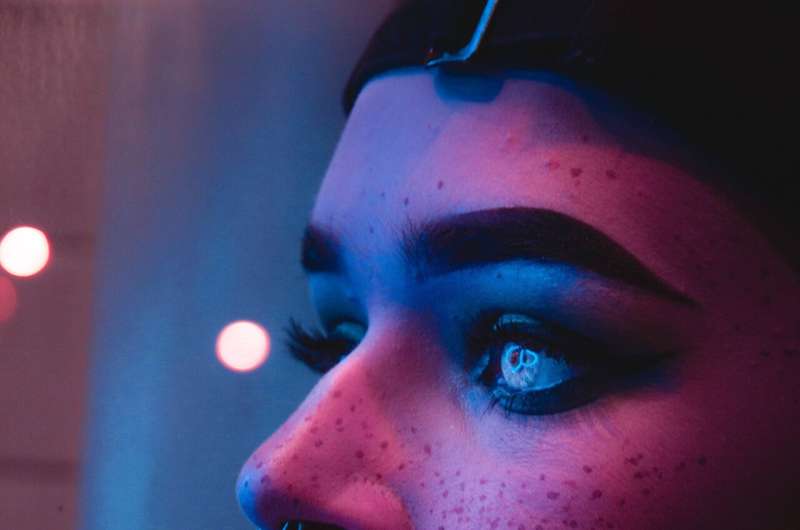This article has been reviewed according to Science X's editorial process and policies. Editors have highlighted the following attributes while ensuring the content's credibility:
fact-checked
trusted source
proofread
Restoring sight to the blind with cutting-edge brain implants

European researchers are striving to improve the technology that could one day help blind people see again.
Berna Gomez, a former science teacher from Spain, became a scientific subject herself in 2021. After being blind for 16 years, she took part in an experiment to restore her ability to perceive light.
Gomez, then 57 years old, was fitted with an implant in the area of the brain responsible for visual processing. The implant consisted of an array of 96 microelectrodes.
Brain signals
With the microelectrodes linked to a video camera on a pair of glasses, Gomez was able visually to decipher the signals being communicated to her brain. She could discern the outline of objects, identify left from right hand gestures and even play maze-like video games.
While her case marked a noteworthy advance, researchers are taking another step forward by making electrodes smaller so that a greater number can be fitted into any blind person. This work is improving visual prostheses.
"The more electrodes, the higher the visual resolution," said Professor Shih-Chii Liu of the Institute of Neuroinformatics at the University of Zurich in Switzerland.
Liu coordinates a project developing high-performance electrodes that are around four times thinner than a human hair.
Called NeuraViPeR, the initiative began in September 2020 and is due to run until the end of February 2025.
Steady progress
In 2019, a Global Burden of Disease study ranked vision impairment including blindness as the third-leading cause of years lived with disability.
Europe has more than 2.5 million residents who are blind, according to a leading advocacy group.
Leading causes of blindness include cataract, whereby the lens of the eye becomes opaque; glaucoma, which impairs the optic nerve; and age-related macular degeneration, which harms the retina. Other causes are diabetes-induced damage, genetic conditions, accidents and infections.
Some of these conditions could be treatable with brain implants.
Because medical remedies for blindness are currently limited, the best help for blind people is often a guide dog, a cane or personal assistance.
In the 1990s, scientists began taking baby steps towards an artificial eye for blind patients by implanting electrodes in the brain part—the visual cortex—that deals with vision. These miniscule metal contact points can interact with brain cells to convey visual information.
The difficulty was that the electrodes were still relatively bulky and only a limited number could be implanted into brain tissue.
More electrodes
For all its success, the implant in Gomez lacked the number of electrodes needed for her to recognize objects or to regain enough sight for use in daily life. She had the implant for six months.
Today, advances in neurotechnology have made it possible to reduce the size of electrodes so that around 100 of them can be surgically implanted into the brain. But this is still too few for the needed resolution.
To be able to discern a face or enough of the outlines of objects in the real world to navigate, say, a room, a blind person would need to have between 1,000 and 2,000 electrodes inserted surgically into the visual cortex.
"Normal vision has a resolution of 1 million pixels," said Liu.
The implants being developed under NeuraViPer contain thousands of electrodes embedded in flexible strips. This will significantly increase visual resolution and improve the safety of the implant by reducing the risk of scarring or a negative immune response.
Information highway
Increasing the electrode count is only part of the solution. If visual prostheses are going to restore sight to the blind, they'll also need to be able to transfer much more information than is currently the case.
In short, the capacity of the electrodes needs to be increased to stimulate the brain and effectively communicate the images captured by the camera.
"Blindness is really a huge problem," said Peter Janssen, professor of neurosciences at the Leuven Brain Institute in Belgium. "We have almost no therapeutic options for these people."
Janssen is leading a separate project investigating ways of improving the stimulation patterns of electrodes so that they're able to convey more information to the brain's neurons. Called HyperStim, it began in November 2022 and will run for four years.
Current visual prostheses use very simple stimulation patterns. HYPERSTIM is seeking to apply more sophisticated ones for available electrodes. The aim is to obtain a resolution of at least 20 times the number of electrodes physically present, and as a result, fundamentally improve the quality of vision that it may be possible to achieve.
Learning curve
The first blind people to receive a visual prosthetic in the brain, connected to an external camera, won't suddenly have their vision fully restored, according to Janssen. That's because the brain itself needs time after an implant to decode the message received from the camera.
"The brain has to learn how to interpret the electrical stimulation," Janssen said.
Instead of fully restored vision, a rough black and white image with contours and outlines of objects is likely to be created in the brain—enough nonetheless to give the person greater mobility and independence.
All in all, advances in medical technology spurred by projects such as HyperStim and NeuraViPeR mean the prospects for people who have lost their sight are improving all the time.
More information:
This article was originally published in Horizon, the EU Research and Innovation Magazine.


















